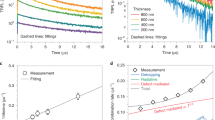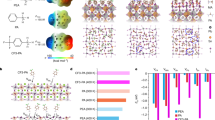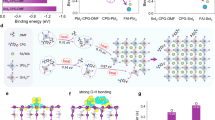Abstract
All-perovskite tandem solar cells hold great promise in surpassing the Shockley–Queisser limit for single-junction solar cells1,2,3. However, the practical use of these cells is currently hampered by the subpar performance and stability issues associated with mixed tin–lead (Sn–Pb) narrow-bandgap perovskite subcells in all-perovskite tandems4,5,6,7. In this study, we focus on the narrow-bandgap subcells and develop an all-in-one doping strategy for them. We introduce aspartate hydrochloride (AspCl) into both the bottom poly(3,4-ethylene dioxythiophene)–poly(styrene sulfonate) and bulk perovskite layers, followed by another AspCl posttreatment. We show that a single AspCl additive can effectively passivate defects, reduce Sn4+ impurities and shift the Fermi energy level. Additionally, the strong molecular bonding of AspCl–Sn/Pb iodide and AspCl–AspCl can strengthen the structure and thereby improve the stability of Sn–Pb perovskites. Ultimately, the implementation of AspCl doping in Sn–Pb perovskite solar cells yielded power conversion efficiencies of 22.46% for single-junction cells and 27.84% (27.62% stabilized and 27.34% certified) for tandems with 95% retention after being stored in an N2-filled glovebox for 2,000 h. These results suggest that all-in-one AspCl doping is a favourable strategy for enhancing the efficiency and stability of single-junction Sn–Pb perovskite solar cells and their tandems.
This is a preview of subscription content, access via your institution
Access options
Access Nature and 54 other Nature Portfolio journals
Get Nature+, our best-value online-access subscription
$29.99 / 30 days
cancel any time
Subscribe to this journal
Receive 51 print issues and online access
$199.00 per year
only $3.90 per issue
Buy this article
- Purchase on Springer Link
- Instant access to full article PDF
Prices may be subject to local taxes which are calculated during checkout




Similar content being viewed by others
Data availability
All data are available in the main text or supplementary materials. The data and code that support the findings of this study are available from the corresponding authors on request.
References
He, R. et al. Wide-bandgap organic–inorganic hybrid and all-inorganic perovskite solar cells and their application in all-perovskite tandem solar cells. Energy Environ. Sci. 14, 5723–5759 (2021).
He, R. et al. All-perovskite tandem 1 cm2 cells with improved interface quality. Nature 618, 80–86 (2023).
Zhang, W. et al. Revealing key factors of efficient narrow-bandgap mixed lead-tin perovskite solar cells via numerical simulations and experiments. Nano Energy 96, 107078 (2022).
Li, C. et al. Low-bandgap mixed tin–lead iodide perovskites with reduced methylammonium for simultaneous enhancement of solar cell efficiency and stability. Nat. Energy 5, 768–776 (2020).
Tong, J. et al. Carrier control in Sn–Pb perovskites via 2D cation engineering for all-perovskite tandem solar cells with improved efficiency and stability. Nat. Energy 7, 642–651 (2022).
Ke, W., Stoumpos, C. C. & Kanatzidis, M. G. “Unleaded” perovskites: status quo and future prospects of tin-based perovskite solar cells. Adv. Mater. 31, 1803230 (2019).
Lin, R. et al. All-perovskite tandem solar cells with 3D/3D bilayer perovskite heterojunction. Nature 620, 994–1000 (2023).
Yoo, J. J. et al. Efficient perovskite solar cells via improved carrier management. Nature 590, 587–593 (2021).
Liao, W. et al. Fabrication of efficient low-bandgap perovskite solar cells by combining formamidinium tin iodide with methylammonium lead iodide. J. Am. Chem. Soc. 138, 12360–12363 (2016).
Huang, L. et al. Efficient narrow‐bandgap mixed tin‐lead perovskite solar cells via natural tin oxide doping. Adv. Mater. 35, 2301125 (2023).
Jiang, Q. et al. Compositional texture engineering for highly stable wide-bandgap perovskite solar cells. Science 378, 1295–1300 (2022).
Tong, J. et al. Carrier lifetimes of >1 μs in Sn-Pb perovskites enable efficient all-perovskite tandem solar cells. Science 364, 475–479 (2019).
Lin, R. et al. All-perovskite tandem solar cells with improved grain surface passivation. Nature 603, 73–78 (2022).
Xiao, K. et al. All-perovskite tandem solar cells with 24.2% certified efficiency and area over 1 cm2 using surface-anchoring zwitterionic antioxidant. Nat. Energy 5, 870–880 (2020).
Wang, Z. et al. Suppressed phase segregation for triple-junction perovskite solar cells. Nature 618, 74–79 (2023).
Chen, H. et al. Regulating surface potential maximizes voltage in all-perovskite tandems. Nature 613, 676–681 (2023).
Saidaminov, M. I. et al. Suppression of atomic vacancies via incorporation of isovalent small ions to increase the stability of halide perovskite solar cells in ambient air. Nat. Energy 3, 648–654 (2018).
Chen, B., Rudd, P. N., Yang, S., Yuan, Y. & Huang, J. Imperfections and their passivation in halide perovskite solar cells. Chem. Soc. Rev. 48, 3842–3867 (2019).
Liu, C. et al. Highly efficient quasi‐2D green perovskite light‐emitting diodes with bifunctional amino acid. Adv. Opt. Mater. 10, 2200276 (2022).
Xu, J. et al. Triple-halide wide-band gap perovskites with suppressed phase segregation for efficient tandems. Science 367, 1097–1104 (2020).
Li, G. et al. Ionic liquid stabilizing high‐efficiency tin halide perovskite solar cells. Adv. Energy Mater. 11, 2101539 (2021).
Zheng, X. et al. Quantum dots supply bulk- and surface-passivation agents for efficient and stable perovskite solar cells. Joule 3, 1963–1976 (2019).
Liu, F. et al. Is Excess PbI2 beneficial for perovskite solar cell performance? Adv. Energy Mater. 6, 1502206 (2016).
Jiang, Q. et al. Planar-structure perovskite solar cells with efficiency beyond 21%. Adv. Mater. 29, 1703852 (2017).
Ke, W. et al. Employing lead thiocyanate additive to reduce the hysteresis and boost the fill factor of planar perovskite solar cells. Adv. Mater. 28, 5214–5221 (2016).
Tumen‐Ulzii, G. et al. Detrimental effect of unreacted PbI2 on the long‐term stability of perovskite solar cells. Adv. Mater. 32, 1905035 (2020).
Hu, S. et al. Optimized carrier extraction at interfaces for 23.6% efficient tin–lead perovskite solar cells. Energy Environ. Sci. 15, 2096–2107 (2022).
Yokoyama, T. et al. Overcoming short-circuit in lead-free CH3NH3SnI3 perovskite solar cells via kinetically controlled gas–solid reaction film fabrication process. J. Phys. Chem. Lett. 7, 776–782 (2016).
Li, P. et al. Ligand engineering in tin-based perovskite solar cells. Nanomicro Lett. 15, 167 (2023).
Shao, W. et al. Modulation of nucleation and crystallization in PbI2 films promoting preferential perovskite orientation growth for efficient solar cells. Energy Environ. Sci. 16, 252–264 (2023).
Ye, F. et al. Roles of MACl in sequentially deposited bromine-free perovskite absorbers for efficient solar cells. Adv. Mater. 33, 2007126 (2021).
Liu, Y. et al. A generic lanthanum doping strategy enabling efficient lead halide perovskite luminescence for backlights. Sci. Bull. 68, 1017–1026 (2023).
Lee, J.-W. et al. Formamidinium and cesium hybridization for photo- and moisture-stable perovskite solar cell. Adv. Energy Mater. 5, 1501310 (2015).
Liao, Y. et al. Highly oriented low-dimensional tin halide perovskites with enhanced stability and photovoltaic performance. J. Am. Chem. Soc. 139, 6693–6699 (2017).
Glowienka, D. & Galagan, Y. Light intensity analysis of photovoltaic parameters for perovskite solar cells. Adv. Mater. 34, 2105920 (2022).
Huang, Z., Hu, X., Liu, C., Tan, L. & Chen, Y. Nucleation and crystallization control via polyurethane to enhance the bendability of perovskite solar cells with excellent device performance. Adv. Funct. Mater. 27, 1703061 (2017).
Kapil, G. et al. Tin‐lead perovskite fabricated via ethylenediamine interlayer guides to the solar cell efficiency of 21.74%. Adv. Energy Mater. 11, 2101069 (2021).
Kuan, C. H. et al. Dopant‐free pyrrolopyrrole‐based (PPr) polymeric hole‐transporting materials for efficient tin‐based perovskite solar cells with stability over 6000 h. Adv. Mater. 35, 2300681 (2023).
Wang, J. et al. Carbazole-based hole transport polymer for methylammonium-free tin–lead perovskite solar cells with enhanced efficiency and stability. ACS Energy Lett. 7, 3353–3361 (2022).
Clark, S. J. et al. First principles methods using CASTEP. Z. Kristallogr. Cryst. Mater. 220, 567–570 (2005).
Grimme, S. Semiempirical GGA-type density functional constructed with a long-range dispersion correction. J. Comput. Chem. 27, 1787–1799 (2006).
Kresse, G. & Hafner, J. Ab initio molecular dynamics for liquid metals. Phys. Rev. B 47, 558–561 (1993).
Kresse, G. & Furthmüller, J. Efficient iterative schemes for ab initio total-energy calculations using a plane-wave basis set. Phys. Rev. B 54, 11169–11186 (1996).
Blöchl, P. E. Projector augmented-wave method. Phys. Rev. B 50, 17953–17979 (1994).
Kresse, G. & Joubert, D. From ultrasoft pseudopotentials to the projector augmented-wave method. Phys. Rev. B 59, 1758–1775 (1999).
Perdew, J. P., Burke, K. & Ernzerhof, M. Generalized gradient approximation made simple. Phys. Rev. Lett. 77, 3865–3868 (1996).
Grimme, S., Antony, J., Ehrlich, S. & Krieg, H. A consistent and accurate ab initio parametrization of density functional dispersion correction (DFT-D) for the 94 elements H-Pu. J. Chem. Phys. 132, 154104 (2010).
Acknowledgements
This work was supported by Key Lab of Artificial Micro- and Nanostructures of Ministry of Education of China, Wuhan University. We thank the Core Facility of Wuhan University for SEM, ToF-SIMS and XPS measurements. We also acknowledge the financial support from the National Natural Science Foundation of China (Grant Numbers: 12174290, 12134010) and the Natural Science Foundation of Hubei Province, China (Grant Number: 2021CFB039).
Author information
Authors and Affiliations
Contributions
S.Z. and W.K. conceived the idea and designed the experiments. S.Z., S.F. and Chen W. developed tandem solar cells. W.M. performed DFT calculation and theoretical analysis. J.Z. conducted SCLC measurements. Y.Z. performed EIS characterization and analysis. D.P. characterized the surface and cross-section morphology of perovskite films and devices. Q.L. participated in the optimization of single-junction NBG and tandem solar cells. Cheng W. and T.W. conducted photoluminescence and transient absorption measurements and analysis. L.H. conducted XPS measurements and analysis. H.G. conducted ToF-SIMS and KPFM measurements and their analysis. W.Z. conducted the long-term device stability measurements and analysis. G.Z. conducted tandem EQE measurements. K.D. and H.C. conducted XRD measurements and their analysis. S.W. conducted UPS and absorption measurements. S.Z. and W.K. wrote the first draft of the manuscript. All authors discussed the results and contributed to the revisions of the manuscript. G.F. and W.K. supervised the project.
Corresponding authors
Ethics declarations
Competing interests
The authors declare no competing interests.
Peer review
Peer review information
Nature thanks Jiangzhao Chen and the other, anonymous, reviewer(s) for their contribution to the peer review of this work.
Additional information
Publisher’s note Springer Nature remains neutral with regard to jurisdictional claims in published maps and institutional affiliations.
Supplementary information
Supplementary Information
Supplementary Notes, Figs. 1–36 and Tables 1–6.
Rights and permissions
Springer Nature or its licensor (e.g., a society or other partner) holds exclusive rights to this article under a publishing agreement with the author(s) or other rightsholder(s); author self-archiving of the accepted manuscript version of this article is solely governed by the terms of such publishing agreement and applicable law.
About this article
Cite this article
Zhou, S., Fu, S., Wang, C. et al. Aspartate all-in-one doping strategy enables efficient all-perovskite tandems. Nature 624, 69–73 (2023). https://doi.org/10.1038/s41586-023-06707-z
Received:
Accepted:
Published:
Issue Date:
DOI: https://doi.org/10.1038/s41586-023-06707-z
This article is cited by
-
Mixed tin-lead perovskites with balanced crystallization and oxidation barrier for all-perovskite tandem solar cells
Nature Communications (2024)
Comments
By submitting a comment you agree to abide by our Terms and Community Guidelines. If you find something abusive or that does not comply with our terms or guidelines please flag it as inappropriate.



